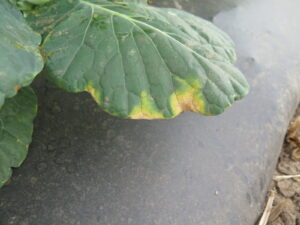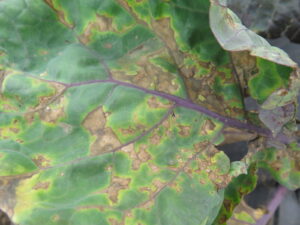Cabbage is the crop most often affected by black rot, however, other crucifers such as broccoli, cauliflower, mustard, kohlrabi or brussels sprouts may be affected. The first symptom one is likely to notice is a V-shaped lesion on the margin of the leaf (Figure 1). However, severe symptoms may become irregular and jagged (Figure 2). The differences may be due to differences in susceptibility of the crops/cultivars or the leaf in Figure 2 may have been infected at an earlier age than the one in Figure 1. You may want to compare these symptoms to those in the article about Alternaria leaf spot in this issue of the Hotline.
Black rot is most severe in wet, warm weather. The emergence of this disease during a rather cold spring may mean that the disease started in a greenhouse situation.
The bacterium that causes black rot, Xanthomonas campestris, survives in crop residue. Thus, crop rotations that avoid crucifers should lessen the severity of the disease. Sanitation in the greenhouse should help to lessen the amount of the bacterium that can cause more disease. The causal bacterium may also be transmitted through seeds, therefore, every effort should be made to plant seed that has been tested and found free of the bacterium. Inspect transplants for symptoms before planting. Avoid practices which add to free water on plant surfaces. Products which contain copper as an active ingredient may help to lessen the spread of the disease. However, copper products may also cause lesions on leaves under sohttps://btny.purdue.edu/Pubs/ID/ID-56/me circumstances. Although there may be varietal differences in susceptibility, complete levels of resistance are not available in commercial cultivars. More information about general pest management can be found in the Midwest Vegetable Production Guide for Commercial Growers (mwveguide.org).

